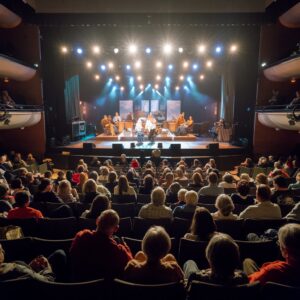Live theatre holds a unique place in the performing arts, offering an experience unlike any other. It’s an intricate tapestry woven with talent, dedication, and emotion. For performers, the journey from the audition room to a standing ovation on opening night is one of transformation, growth, and unparalleled fulfillment. This article delves into the key stages of a performer’s journey in live theatre, highlighting the challenges and triumphs of bringing a production to life.
the performing arts, offering an experience unlike any other. It’s an intricate tapestry woven with talent, dedication, and emotion. For performers, the journey from the audition room to a standing ovation on opening night is one of transformation, growth, and unparalleled fulfillment. This article delves into the key stages of a performer’s journey in live theatre, highlighting the challenges and triumphs of bringing a production to life.
The Audition: A Leap of Faith
Every journey begins with a single step; for performers, it starts in the audition room. At auditions, hopefuls showcase their skills, hoping to catch the director’s eye and secure a coveted role. These brief moments—a monologue, a song, or a dance combination—are packed with pressure.
Preparation is paramount. Memorizing lines, honing vocal techniques, and perfecting choreography can mean the difference between landing a role and being passed over. But auditions are more than just demonstrating talent; they’re about showing adaptability, professionalism, and the potential to grow into the role. The key takeaway? Resilience is essential. Rejection is part of the process, but each audition is a stepping stone to the next opportunity.
Rehearsals: Building the Foundation
Once cast, the real work begins. Rehearsals are the backbone of any successful production. They are where the script transitions from words on a page to a living, breathing story.
Table reads often mark the beginning, allowing the cast to familiarize themselves with the script and characters. As rehearsals progress, blocking, choreography, and music are layered in. Collaboration is at the heart of this stage. Performers work closely with directors, choreographers, and fellow cast members to create chemistry and coherence.
Challenges can arise—tight schedules, complex staging, or even moments of self-doubt. Yet, rehearsals are where they refine their craft and find their characters’ truths and the ensemble’s trust. The camaraderie formed in these weeks often lasts long after the final curtain call.
Tech Week: The Final Stretch
Affectionately known as “Hell Week,” tech week is where all production elements come together. Lighting, sound, costumes, and set pieces are integrated to create the world of the play. For performers, it’s a time of adjustment and patience.
Costume fittings and quick changes add new dimensions to performances, while sound cues and microphones introduce logistical hurdles. Running scenes under full lights and with props can feel overwhelming but also exhilarating. Tech Week transforms a collection of scenes into a cohesive spectacle, bringing performers one step closer to their audience.
Opening Night: The Moment of Truth
The energy on opening night is electric. The culmination of weeks, sometimes months, of hard work is finally unveiled to an eager audience. For performers, the adrenaline rush is unmatched. Nerves and excitement blend into a powerful force that propels them onto the stage.
Every line delivered, note sung, and movement executed is an act of vulnerability. Live theatre’s unpredictability—missed cues, forgotten lines, or technical glitches—requires performers to think on their feet. Yet, this raw, unfiltered nature is what makes it so captivating.
The Standing Ovation: A Performer’s Reward
There is no greater reward for a performer than the sound of applause, especially a standing ovation. The hard work, sacrifices, and passion come full circle in a moment of connection. Audience appreciation is a testament to the transformative power of theatre—for both the performer and the spectator.
But the journey doesn’t end here. Each performance is an opportunity to refine and grow. A live production evolves with every show, and performers continuously strive to deliver their best.
Beyond the Stage: The Lifelong Impact
The journey from audition to standing ovation leaves an indelible mark on performers. The lessons learned—resilience, teamwork, adaptability—extend beyond the theatre. Whether they continue in the arts or pursue other paths, the experience shapes them into dynamic individuals with a profound appreciation for storytelling and human connection.
Live theatre is more than just entertainment; it is an art form that fosters empathy, creativity, and community. For those who embark on this journey, the standing ovation is not just a reward but a reminder of the magic they helped create.
